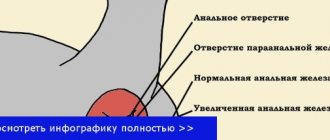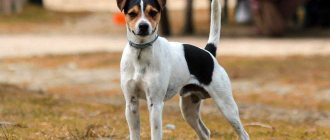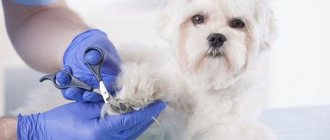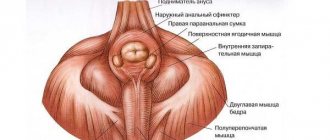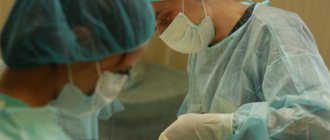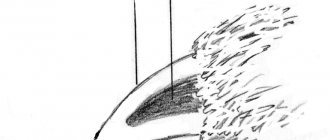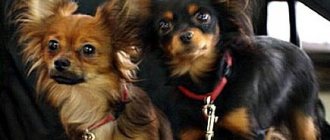Many people love dogs and keep them at home, but very few people know the anatomy of their pets thoroughly. For the most part, these are breeders and people related to medicine or veterinary medicine. And it is necessary to know the peculiarities of the functioning of the dog’s body, at least in order to be able to recognize the signs of impending health troubles.
One of these issues that can confuse an uninformed person is blockage of the paraanal glands. Most people are not even aware of their presence in animals. Clogging of these formations leads to very unpleasant consequences, so pet owners must not only be able to recognize the symptoms of disorders, but also know well how to clean the glands.
What kind of organ are the paraanal glands?
The occurrence of complications is often associated with a lack of appropriate knowledge. After all, detecting a diseased organ without knowing about its existence is an almost impossible task. To fill in the gaps, it is enough to clarify only 2 points: find out the location and features of the functioning of the paraanal glands.
Location
The mysterious organ is hidden right behind the anus - not far from its transition to the rectum. It consists of two symmetrical “bags” filled with odorous secretion. Due to their location, these seals cannot be seen, but can be felt.
Operation
The secretion secreted by the paraanal glands in dogs has an individual smell. It is this that animals “read” when getting to know each other, when they sniff the back of the body of a new acquaintance.
In the absence of pathologies, the secretion produced periodically comes out. This occurs when defecation, leaving territorial marks or strong emotional arousal.
When natural outflow is disrupted, fluid accumulates inside. Blockage of the excretory ducts is accompanied by inflammation of the organ. This can lead to a number of complications, including tissue rupture. To save the animal, cleansing is done manually.
What happens if you do not contact a veterinarian in time if there is a pathology?
Don't think that the problem will solve itself. As we have already said, the accumulated secretion in the anal sacs becomes an excellent breeding ground for the proliferation of pathogenic bacteria. If clogged anal glands are not cleared, your pet will require lengthy and complex treatment.
Signs of a worsening situation are:
- pain experienced by the pet during bowel movements (he may whine, grunt, etc.);
- hair loss;
- redness of the tissues near the anus;
- wet areas;
- presence of fistulas;
- swelling in the anal area;
- presence of irritation, etc.
In such cases, the animal needs urgent help from a specialist. You cannot clean the anal glands yourself!
Possible causes of inflammation
For pets, the exocrine function has long ceased to be necessary. They do not fight for the female and rarely mark territory. The once important organ gradually becomes rudimentary and is less and less cleansed naturally.
Other causes of inflammation of the paraanal glands in dogs include:
- low activity and excess weight, which impair intestinal motility;
- frequent digestive problems including diarrhea and constipation;
- weak immunity;
- improper feeding of bones, excess protein, insufficient or excessive amount of fiber in the diet;
- frequent mating and pregnancy;
- infection with bacteria, viruses or helminths;
- anal area injuries;
- infrequent walks, forcing you to restrain the urge to defecate;
- neglect of hygiene;
- congenital disorders in the development and position of the organ.
Establishing the cause of inflammation is an important part of further therapy. Eliminating it increases the chances of preventing relapses.
Medical therapy
During the examination, it may be necessary to open the gland, which involves cleaning and disinfecting the ulcer. After surgery, medicinal suppositories are prescribed. It is mandatory to wear a special collar that does not allow reaching the damaged area.
In cases where inflammation is constantly forming and the glands are cleaned every seven days, then complete removal of the anal gland would be a good option. This surgical intervention is simple and does not generally cause any consequences. The dog will need light food and frequent walks for some time to improve bowel function and frequent bowel movements.
Symptoms by stage of development
Depending on the symptoms that appear during inflammation of the paraanal glands in dogs, the pathological process is divided into 4 stages. As the serial number increases, the likelihood of complications aggravating further treatment increases.
First stage
The initial stage is accompanied by severe itching and a gradual reduction in the amount of secretion produced. It remains transparent or acquires a yellowish tint. To eliminate itching, the dog constantly licks himself or cuts circles on his butt.
This symptomatology is similar to helminthiasis. Do not rush to give an anthelmintic before diagnosis. Not only will this not help, but it will also weaken your immune system.
Second stage
The development of inflammation is accompanied by thickening of the secretory fluid and a reduction in its volume. Due to frequent scratching, the hair in the affected area begins to fall out. The inner surface of the thighs is covered with tiny bubbles with transparent or cloudy contents. The hind limbs are constrained by spasms that impair coordination.
Third stage
Secretory fluid is practically not secreted. It resembles a thick cream and becomes darker. Due to the growth of bacteria attracted by stagnation, inflammation spreads to adjacent tissues. The spasms get worse. Instead of single muscle contractions, cramps appear.
Fourth stage
The escaping liquid resembles grainy cottage cheese and turns black. If the ducts are completely blocked, paralysis of the hind limbs and the development of an abscess are possible. The patient experiences severe pain not only during bowel movements, but also at rest. A sharp increase in temperature to 40 °C indicates blood poisoning, which can be fatal. The animal requires urgent hospitalization.
Saculectomy
Sakulectomy is the removal of the paraanal glands. There are cases when they become clogged regularly in dogs. The secretion cannot come out, even with regular cleaning. If there is no inflammation or abscess, then the cleaning procedure is at least painless, but still not the most pleasant.
Wherever it goes, if the glands need to be cleaned once a year. If this needs to be done constantly, almost every week. It is much more humane to perform an operation to remove it than to torture your pet and constantly treat and clean the inflamed gland.
The operation to remove the glands is not considered difficult. The doctor makes 2 small incisions in the skin, approximately above the glands. Then he brings the glands out (from the anus), cuts them off and sews up the wounds. Neither the anus nor the rectum are damaged. To prevent the stitches from coming apart, after such an operation you need light feeding and frequent walking.
At-risk groups
The risk group includes pregnant and lactating females, as well as some representatives of small breeds: dachshunds, pugs, Pekingese, Spitz, Shih Tzu. If you follow the recommended caloric intake of food and regularly walk your pet, not forgetting about outdoor games, make sure that he is not naturally prone to excess weight. In this case, any deviation from the listed actions is fraught with the sudden development of pathology.
Diagnosis of the disease
An examination in a veterinary clinic is carried out to exclude similar pathologies, identify the cause and stage of the inflammatory process. You shouldn’t delay making an appointment until your condition worsens. Lethargy, lack of appetite and unbearable itching are quite serious symptoms that require a mandatory examination of the four-legged patient.
The list of mandatory diagnostic tests includes a blood test, skin scraping and assessment of secretions. If there is pus, blood or a foul odor, a bacterial culture test is also taken, which determines the type of bacteria and their sensitivity to antibiotics. Other diagnostic methods are prescribed on an individual basis.
Abscess
Everyone knows: if there is no special hole for removing fluid, then if the gland is full, it will find a place to exit. The wall breaks through and the secretion flows out. An abscess is a small hole through which a yellowish liquid constantly oozes. Neighboring tissues begin to become inflamed and painful, the dog often licks the affected area, bacteria enter the wound and multiply vigorously.
This leads to a sharp deterioration in the animal’s well-being, it becomes lethargic, and the temperature rises. You urgently need to run to the veterinarian, he will show you how to clean the glands so that this does not happen again, remove all the pus and treat the wound. If necessary, drainage is installed and suppositories are prescribed, for example, Proctosedyl. In difficult cases, a course of antibiotics is indicated to suppress the growth and reproduction of bacteria.
Treatment methods
In most cases, the blockage is removed by mechanical cleaning. Rinse and surgery are prescribed when the process is advanced, and drugs are used to eliminate inflammation and kill bacteria.
Drug therapy
For inflammation of the paraanal glands in a dog, rectal suppositories (Methyluracil, Proctosedyl, ichthyol suppositories) are used for treatment. They not only have an anti-inflammatory effect, but also increase tissue regeneration. A contraindication for use is a violation of the integrity of the organ.
To relieve pain, a novocaine blockade is prescribed, and the bacterial infection is eliminated with a course of antibiotic therapy. Due to possible side effects, all dosages and duration of treatment are determined by the doctor.
Washing
Patients with stages 3 and 4 of the inflammatory process undergo washing of the “bags”, clearing them of accumulated pus. During the procedure, local anesthesia is used. After opening the abscess, the surgeon removes its contents and rinses the ducts with an antibacterial solution. The resulting wound heals quickly if you avoid licking it with a veterinary cone.
Mechanical cleaning
In the first stages, the blockage is removed by mechanical cleaning. It is carried out in 2 ways:
- Outer
. The “bags” are wrapped around the outside with your fingers and squeezed towards each other. After the fluid has drained, the anus is treated with Vaseline.
- Interior
. With a finger inserted into the anus, you need to feel the inflamed organ and try to squeeze out the secretion from it through gentle massage movements.
The second method is carried out strictly in a veterinary clinic, since in the absence of skills it can lead to injury to the anus. The external method is easier and less dangerous, so it can be used at home.
Surgical intervention - removal
In case of advanced inflammatory process, congenital pathologies or frequent relapses, anal sacculectomy is recommended, that is, removal of the “sacs”. The operation does not affect the quality of bowel movements, since it does not affect the anus and rectum. Within a day, the pet returns to normal activity.
During rehabilitation, it is important to increase the frequency of walking. Frequently holding back the urge leads to constipation, which can lead to sutures coming apart. Wound healing is also facilitated by following a special diet.
Factors
The accumulation of secretions in domestic dogs can be caused by:
- A hereditary factor that manifests itself in small breeds that are prone to obesity (this often occurs in pugs, dachshunds and bulldogs);
- The sedentary lifestyle of dogs leads to difficulty in releasing secretions;
- Eating a pet from a common table leads to this problem;
- Often, at a veterinarian's appointment, examination of the anus is ignored and, as a result, the animal owner may not be aware of the accumulation of discharge.
Preventive measures to prevent stagnation are two active walks a day. Sometimes the anal area should be washed and massaged.
Dietary regime
The diet is based on easily digestible foods enriched with fiber. Regular consumption of dietary fiber prevents blockage of the ducts by stimulating peristalsis. Additionally, you can take vitamin and mineral complexes prescribed by your veterinarian.
To prevent constipation and diarrhea, it is recommended to use only fresh food, avoiding reheating food. To avoid overfeeding and excessive stress on the intestines, increase the frequency of feedings by reducing the size of portions. Eliminate all prohibited foods from your diet: canned food, sweets, pickles and other dishes from the human table.
When dry feeding, it is recommended to choose food from a veterinary line. Pay attention to the series recommended for digestive problems. The exact brand and serving size should be checked with your doctor.
Do-it-yourself cleaning at home
Self-cleaning is carried out for preventive purposes when the diagnosis is already known. For the safety of your pet, it is important to rule out other diseases and make sure there are no complications.
Frequency
On average, it is enough to clean the ducts every six months. Depending on the individual characteristics of the animal, the interval can be increased or decreased. If blockage occurs monthly or even more often, then the problem is eliminated surgically.
How to perform the procedure
It is better to perform the procedure in the bathroom while washing. If you live in a private house, you can go outside during the warm season. Prepare old, unwanted clothing and latex gloves in advance to protect yourself from odorous secretions. Also make sure you have an assistant ready to restrain the dog.
Armed with Vaseline, napkins and a basin, proceed with the following actions with your partner:
- Place your pet in the bathtub and gently lift his tail towards his back. Place your pelvis directly under your anus. It is enough to simply place a small dog in a basin.
- Gently feel the anal area, looking for two lumps.
- Lubricate the anus with Vaseline and gently squeeze the seals, placing a napkin under the leaking secretion.
- After the accumulated fluid has come out, wash your dog and re-lubricate his anus with Vaseline. Use rectal suppositories for the next 4 days.
If there is no secretion, do not increase the pressing force. This may harm the animal. Complex cases are treated only under the supervision of a veterinarian.
Is it possible to check on your own whether your pet’s sinuses are blocked?
When the anal sinuses are in normal condition, they are empty and feel soft to the touch. You should wear sterile rubber gloves and carefully insert your finger into the anus and examine its walls in search of seals.
Of course, this is not the most pleasant procedure for both the owner and the pet. And if you are not a professional, you can press too hard and harm your pet’s health. Therefore, it is better to consult a doctor or grooming specialist.
Possible complications
Prolonged blockage of the ducts attracts pathogenic microorganisms that cause an inflammatory process. This leads to the development of suppuration and damage to nerve endings. The lethal outcome increases with the development of sepsis.
Abscess
An abscess of the paraanal glands in a dog is accompanied by an increase in body temperature, redness and swelling of the anal area. The formation filled with pus can break through at any time and infect neighboring tissues, forming a fistula.
Fistula
Fistula is a cavity formed after opening an abscess. A small hole appears near the anus. It oozes white, yellow or greenish pus with a pungent odor. It may contain blood impurities.
Intestinal problems
Damage to the intestinal mucosa, caused by the appearance of an abscess or fistula, complicates the act of defecation. Constipation occurs, which can lead to intestinal obstruction. Accumulating feces can lead to intestinal rupture and intoxication of the body.
Characteristic symptoms
Undetected stagnation of secretions in time leads to inflammation of the organ. This can be understood by the following manifestations:
- The animal rubs against the floor on an uneven surface;
- Vigorously chews on the hind legs and tail, trying to reach the anus;
- The anal area becomes swollen and red;
- The tail and the area near its base suffers from hair loss.
All these signs may indicate the necessary cleaning of the glands and contact a specialist.
The accumulated secretions can damage the wall of the gland and form an ulcer in the anus. In this state, the dog refuses to eat, becomes lethargic and sleeps a lot. Purulent discharge is constantly released from the ulcerative formation; urgent veterinary attention is required.
